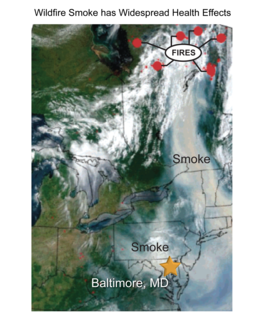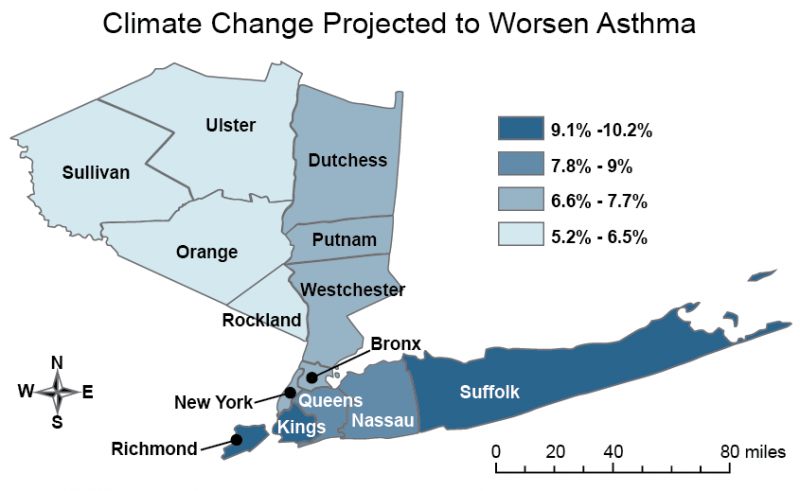Increased Levels of Air Pollutants
Climate variability and change contribute to many negative changes in air quality, including increased ground-level ozone (also known as smog) and higher concentrations of small particulate matter that can reach the deepest parts of the lung.1 Such pollution has been linked to cancer, asthma, allergies, impaired lung development in children, and other health impacts. Warmer and drier conditions associated with climate change can increase the range and severity of wildfires.1 Wildfire smoke contains particulate matter, carbon monoxide, and other harmful emissions that significantly reduce air quality both locally and in areas downwind of fires. Climate change can also lead to higher pollen counts and longer pollen seasons.1
Air pollutant-related health effects
Ground-level ozone and particulate matter are associated with many health problems, such as diminished lung function, more frequent hospital admissions and emergency department visits for asthma, and increases in premature deaths.1
Smoke from wildfires hundreds of miles away can affect people's health. Smoke exposure can cause respiratory and cardiovascular complications that lead to more emergency department visits, hospitalizations, and use of medication to treat asthma, bronchitis, chest pain, and other ailments.
Higher pollen concentrations and longer pollen seasons can increase allergic sensitivity and asthma episodes in some people. Asthma prevalence (the percentage of people who have ever been diagnosed with asthma and still have asthma) increased nationwide during 2001–2010, from 7.3 percent to 8.4 percent.1 Simultaneous exposure to air pollution can worsen allergic response.
Addressing local factors that worsen air quality is a key strategy for reducing the impact of air pollution on human health.
Featured Tools
Benefits Mapping and Analysis Program—Community Edition (BenMAP-CE): BenMAP-CE is a computer program that calculates the number and economic value of deaths and illnesses from changes in air quality, including those related to climate change. BenMap-CE allows communities to enter their own climate and population data to determine the burden to health of air pollution, as well as estimate the benefits of reducing air pollution incrementally. The software is open source to encourage communities to use it for addressing their specific needs.
Energy Savings Plus Health: Indoor Air Quality Guidelines for School Building Upgrades: Climate change affects air quality not just outside, but indoors as well. The Environmental Protection Agency has developed a suite of tools to help communities make energy-efficiency retrofits and upgrades to schools that will help to ensure indoor air quality (IAQ). For instance, a Microsoft Excel®-based Energy Savings Plus Health Checklist generator can be used to develop a custom verification checklist, along with specific assessment protocols and recommended actions tailored to a given project. An IAQ Tools for Schools Action Kit includes checklists, guides, and frameworks for managing indoor air, including specific problems such as asthma or radon, as well as an interactive Problem Solving Wheel that can help school administrators identify IAQ emergencies and determine what actions to take.
Urban Tree Canopy Assessment: Urban tree canopy and forests provide a multitude of health benefits, including improving air quality, lessening heat, and contributing to mental well-being. The U.S. Forest Service’s Urban Tree Canopy Assessment provides communities with tools, including i-Tree, to determine where and how many trees they have, and to help them make planning decisions about planting.
- 1a1b1c1d1eLuber, G., K. Knowlton, J. Balbus, H. Frumkin, M. Hayden, J. Hess, M. McGeehin, N. Sheats, L. Backer, C. B. Beard, K. L. Ebi, E. Maibach, R. S. Ostfeld, C. Wiedinmyer, E. Zielinski-Gutiérrez, and L. Ziska, 2014: Ch. 9: Human Health. Climate Change Impacts in the United States: The Third National Climate Assessment, J. M. Melillo, Terese (T.C.) Richmond, and G. W. Yohe, Eds., U.S. Global Change Research Program, 220–256. doi:10.7930/J0PN93H5.


